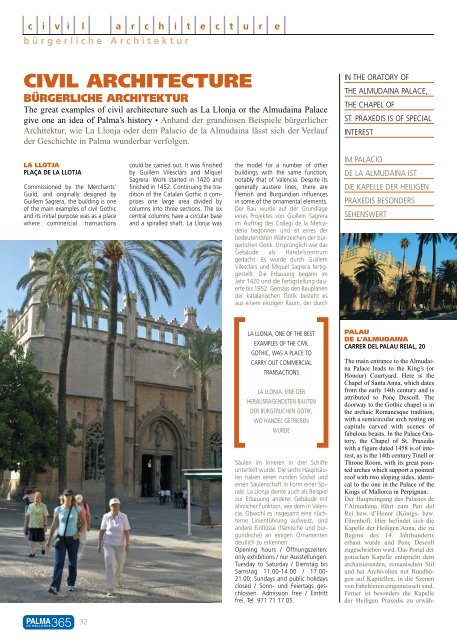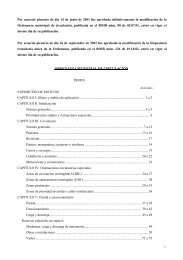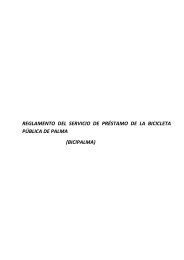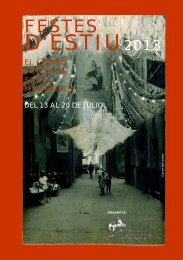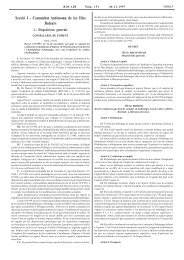e - Ajuntament de Palma
e - Ajuntament de Palma
e - Ajuntament de Palma
Erfolgreiche ePaper selbst erstellen
Machen Sie aus Ihren PDF Publikationen ein blätterbares Flipbook mit unserer einzigartigen Google optimierten e-Paper Software.
| c | i | v| i | l |ooo| a | r | c | h | i | t | e | c | t | u | r | e |<br />
b ü rgerliche Architektur<br />
CIVIL ARCHITECTURE<br />
BÜRGERLICHE ARCHITEKTUR<br />
The great examples of civil architecture such as La Llonja or the Almudaina Palace<br />
give one an i<strong>de</strong>a of <strong>Palma</strong>’s history • Anhand <strong>de</strong>r grandiosen Beispiele bürgerlicher<br />
Architektur, wie La Llonja o<strong>de</strong>r <strong>de</strong>m Palacio <strong>de</strong> la Almudaina lässt sich <strong>de</strong>r Verlauf<br />
<strong>de</strong>r Geschichte in <strong>Palma</strong> wun<strong>de</strong>rbar verfolgen.<br />
LA LLOTJA<br />
PLAÇA DE LA LLOTJA<br />
Commissioned by the Merchants’<br />
Guild, and originally <strong>de</strong>signed by<br />
Guillem Sagrera, the building is one<br />
of the main examples of civil Gothic<br />
and its initial purpose was as a place<br />
where commercial transactions<br />
32<br />
could be carried out. It was finished<br />
by Guillem Vilesclars and Miquel<br />
Sagrera. Work started in 1420 and<br />
finished in 1452. Continuing the tradition<br />
of the Catalan Gothic it comprises<br />
one large area divi<strong>de</strong>d by<br />
columns into three sections. The six<br />
central columns have a circular base<br />
and a spiralled shaft. La Llonja was<br />
the mo<strong>de</strong>l for a number of other<br />
buildings with the same function,<br />
notably that of Valencia. Despite its<br />
generally austere lines, there are<br />
Flemish and Burgundian influences<br />
in some of the ornamental elements.<br />
Der Bau wur<strong>de</strong> auf <strong>de</strong>r Grundlage<br />
eines Projektes von Guillem Sagrera<br />
im Auftrag <strong>de</strong>s Collegi <strong>de</strong> la Merca<strong>de</strong>ria<br />
begonnen und ist eines <strong>de</strong>r<br />
be<strong>de</strong>utendsten Wahrzeichen <strong>de</strong>r bürgerlichen<br />
Gotik. Ursprünglich war das<br />
Gebäu<strong>de</strong> als Han<strong>de</strong>lszentrum<br />
gedacht. Es wur<strong>de</strong> durch Guillem<br />
Vilesclars und Miquel Sagrera fertiggestellt.<br />
Die Erbauung begann im<br />
Jahr 1420 und die Fertigstellung dauerte<br />
bis 1952. Gemäss <strong>de</strong>n Bauplänen<br />
<strong>de</strong>r katalanischen Gotik besteht es<br />
aus einem einzigen Raum, <strong>de</strong>r durch<br />
LA LLONJA, ONE OF THE BEST<br />
EXAMPLES OF THE CIVIL<br />
GOTHIC, WAS A PLACE TO<br />
CARRY OUT COMMERCIAL<br />
TRANSACTIONS<br />
LA LLONJA, EINE DER<br />
HERAUSRAGENDSTEN BAUTEN<br />
DER BÜRGERLICHEN GOTIK,<br />
WO HANDEL GETRIEBEN<br />
WURDE<br />
Säulen im Inneren in drei Schiffe<br />
unterteilt wur<strong>de</strong>. Die sechs Hauptsäulen<br />
haben einen run<strong>de</strong>n Sockel und<br />
einen Säulenschaft in Form einer Spirale.<br />
La Llonja diente auch als Beispiel<br />
zur Erbauung an<strong>de</strong>rer Gebäu<strong>de</strong> mit<br />
ähnlicher Funktion, wie <strong>de</strong>m in Valencia.<br />
Obwohl es insgesamt eine nüchterne<br />
Linienführung aufweist, sind<br />
an<strong>de</strong>re Einflüsse (flämische und burgundische)<br />
an einigen Ornamenten<br />
<strong>de</strong>utlich zu erkennen.<br />
Opening hours / Öffnungszeiten:<br />
only exhibitions / nur Ausstellungen.<br />
Tuesday to Saturday / Dienstag bis<br />
Samstag 11.00-14.00 / 17.00-<br />
21.00; Sundays and public holidays<br />
closed / Sonn- und Feiertags geschlossen.<br />
Admission free / Eintritt<br />
frei. Tel. 971 71 17 05.<br />
IN THE ORATORY OF<br />
THE ALMUDAINA PALACE,<br />
THE CHAPEL OF<br />
ST. PRAXEDIS IS OF SPECIAL<br />
INTEREST<br />
IM PALACIO<br />
DE LA ALMUDAINA IST<br />
DIE KAPELLE DER HEILIGEN<br />
PRAXEDIS BESONDERS<br />
SEHENSWERT<br />
PALAU<br />
DE L’ALMUDAINA<br />
CARRER DEL PALAU REIAL, 20<br />
The main entrance to the Almudaina<br />
Palace leads to the King’s (or<br />
Honour) Courtyard. Here is the<br />
Chapel of Santa Anna, which dates<br />
from the early 14th century and is<br />
attributed to Ponç Descoll. The<br />
doorway to the Gothic chapel is in<br />
the archaic Romanesque tradition,<br />
with a semicircular arch resting on<br />
capitals carved with scenes of<br />
fabulous beasts. In the Palace Oratory,<br />
the Chapel of St. Praxedis<br />
with a figure dated 1458 is of interest,<br />
as is the 14th century Tinell or<br />
Throne Room, with its great pointed<br />
arches which support a pointed<br />
roof with two sloping si<strong>de</strong>s, i<strong>de</strong>ntical<br />
to the one in the Palace of the<br />
Kings of Mallorca in Perpignan.<br />
Der Haupteingang <strong>de</strong>s Palastes <strong>de</strong><br />
l’Almudaina führt zum Pati <strong>de</strong>l<br />
Rei bzw. d’Honor (Königs- bzw.<br />
Ehrenhof). Hier befin<strong>de</strong>t sich die<br />
Kapelle <strong>de</strong>r Heiligen Anna, die zu<br />
Beginn <strong>de</strong>s 14. Jahrhun<strong>de</strong>rts<br />
erbaut wur<strong>de</strong> und Ponç Descoll<br />
zugeschrieben wird. Das Portal <strong>de</strong>r<br />
gotischen Kapelle entspricht <strong>de</strong>m<br />
archaisieren<strong>de</strong>n, romanischen Stil<br />
und hat Archivolten mit Rundbögen<br />
auf Kapitellen, in die Szenen<br />
von Fabeltieren eingemeisselt sind.<br />
Ferner ist beson<strong>de</strong>rs die Kapelle<br />
<strong>de</strong>r Heiligen Praxedis zu erwäh-


